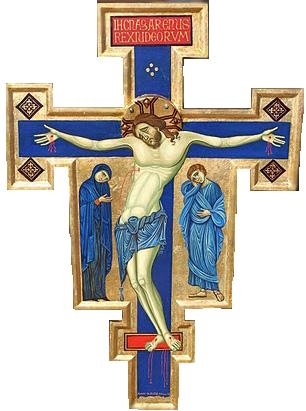
Upon hearing the Call to “rebuild my house,” while in prayer before the Cross of San Damiano, Saint Francis of Assisi began his life’s conversion. However, his response to that Call is reflected through a different cross. Commissioned for the Lower Church of the Basilica Papale e Sacro Convento di San Francesco (Papal Basilica and Sacred Convent of St. Francis), in the mid 1200’s, it is thought that the “Blue Cross” was suspended over the altar at the Tomb of St. Francis. This crucifix is one of a pair created by the “Maestro dei Crocifissi Blu” (Master of the Blue Crucifix), who used blue pigment as a reoccurring element in his work. The other is in the Wallraf-Richartz-Museum in Cologne. The Blue Cross, now located in the Museo del Tesoro (basilica museum), is the artistic representation of the Franciscan answer to God’s Call.

Cross of San Damiano hanging in the Basilica of St. Clare
When the Poor Clares, who were founded by St. Francis as the Second Franciscan Order, moved from San Damiano to Assisi’s Basilica di Santa Chiara (Basilica of St. Clare), they took the cross with them. Before the time of St. Francis and St. Clare, religious art was ruled by strict symbolic representations. The Cross of San Damiano is packed with imagery which is vastly different from the rendering on the Blue Cross. That simplicity of voice is striking. As a comparison, we will focus on the images that they do have in common. Jesus is portrayed as our risen Lord; wounded but strong, on the Cross of San Damiano. In contrast to the symbolism of the Cross of San Damiano, the Blue Cross portrays Christ’s Body in a more humanistic way, as His Blood spills from a dead corpus. This more human artistic representation is part of the Franciscan movement showing that Christ is not only similar to mankind, He is human and suffers as a human. The Blue Cross show the death of Christ. Both show us that through his perfect sacrifice, He gains for us eternal life.
On the Cross of San Damiano there are multiple witnesses to the crucifixion, including Our Lady, St. John the Evangelist, Mary Magdalene, Mary the Mother of James, the Roman centurion who asked Jesus to heal his son, St. Longinus – the centurion who pierced Jesus’ side and later became a Martyr for Him, Stephaton (a faulty derivation from the Greek word for sponge), the traditional name for the Jewish Temple Guard who offered Jesus the sponge soaked in vinegar wine, angels, animals and representations the patron saints of the area. Each of these have specific representational purpose. In the rendering on the Blue Cross are simply are Mary and John, looking toward us in sorrow; sharing in the agony of Jesus’ death. This is a more personal interpretation of the crucifixion, as Christ died for us all, so we are brought into the piece through the faces of Our Lady and St. John.
Fr. Jude Winkler, OFM Conv., a friar from our province who serves the Order as Assistant General CFF: Conventual Franciscan Federation presented information to this year’s graduating Novice class on the replica Blue Crosses they just received.:
